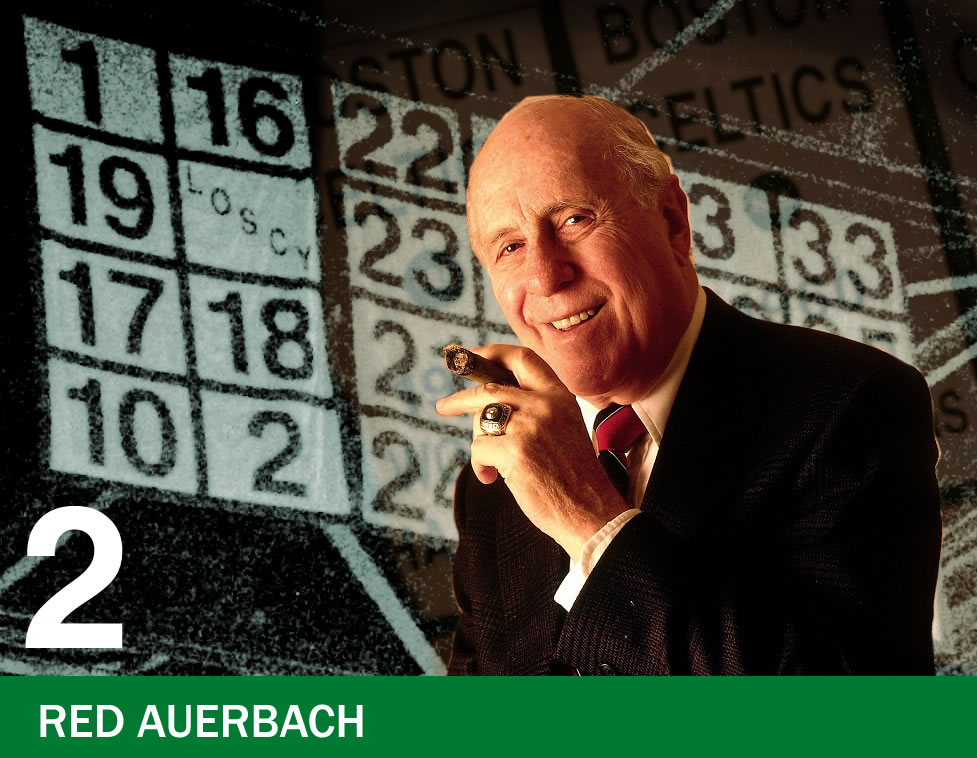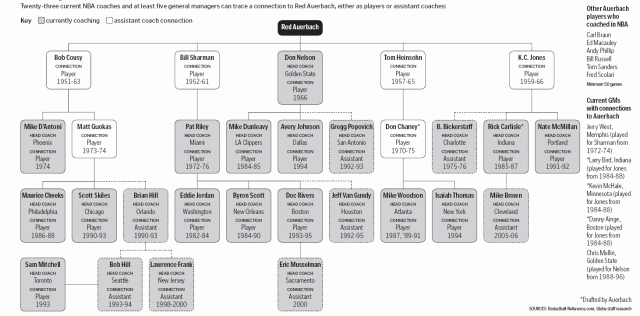From now until February 11, Red’s Army will be posting stories about the players behind the Celtics’ 22 retired numbers and that one retired nickname. Stories will be posted in the order that the numbers were retired.
Geez.
Where do you even start with this guy?
The NBA is Red Auerbach’s league.
Make no mistake about that.
In just over 40 years as coach and general manager, Red drafted, signed or traded for no fewer than 27 players currently enshrined in the Hall-of-Fame.
Over a thirty year period from 1957 to 1986 his Celtics won 16 championships–a period of dominance that we are unlikely to ever see again.
Red’s players have left an indelible mark on the league as well. Although it’s out of date now, the Boston Globe published Red’s coaching tree at the time of his death in 2006, and, well, just look at it:
During Red’s active tenure with the Celtics, the game of basketball changed so much as to become almost unrecognizable.
Basketball, as Red found it, was–to the extent it was anything at all–a high scoring version of hockey. There was no shot clock, offensive strategy was basically ‘throw the ball to the tall guy right by the basket’, and defensive strategy, to the extent that it existed at all, seemed no more sophisticated than trying to injure the opponent.
The jump shot was on its way into basketball when Red was hired in 1950, and the shot clock arrived a few years into his tenure. And, although those two innovations came from other places, Red quickly adapted to them and used them to gain a competitive edge.
Then there were the areas where Red was ahead of the game. Red turned the Celtics into a team full of specialists (including the Sixth Man) at a time when other coaches weren’t even thinking about the game in those terms. By the time the Celtics started that unprecedented run of championships, Red had built a machine for winning basketball games. Red acquired intelligent players, and he taught those players how to use that intelligence on the court. His teams excelled at defense because of it. There’s a reason why so many of Red’s former players went on to successful careers in coaching and management; he valued intelligence in his players–and he recognized it in whatever form (or color) it took.
Along with team owner Walter Brown, Red broke the NBA’s color barrier (Walter Brown, it should be known, went on to break the NHL’s color barrier a few years later). Under Auerbach, the Celtics were the first team in the league to draft a first round player from a historically black college, the first team to field an all-black starting five and the first team to hire a black coach.
And none of this was because Red was trying to prove a point. All of this was because, on the court, Red cared about one thing above all others: winning.
Red didn’t field an all black starting five because of the civil rights movement. He started Sam, KC, Satch, Bill and Willie Naulls the day after Christmas, 1964, because they were the best five players he had available.
It’s not like other coaches in the NBA didn’t want to win back then. They just didn’t, as Red saw it, have their priorities straight. If the most important thing was winning, you started the best available, and you put together the best roster you could find, regardless of how it looked to anyone else (as would be evident in the mid-80s when the Celtics featured lineups with Bill Walton, Kevin McHale, Larry Bird and Danny Ainge, all about the same color as wonder bread).
If you wanted to win, you couldn’t be overly concerned with stuff that has nothing to do with winning. Red knew that skin color had nothing to do with playing basketball.
You couldn’t be too concerned with what other coaches or players thought about you either.
That cigar? That trademark cigar? It grossed Bill Russell out–until he realized what Red was doing with it.
Yes, we all know how Red would light the cigar once he figured the game was over and the Celtics had won. But before that point, Red just chewed on it.
He chewed on it and yelled at the refs. And as he yelled, little bits of cigar would come flying out of his mouth at the ref. Psychological warfare.
It was all psychological warfare. Turn up the heat or turn off the heat in the other team’s locker room? Well, if there’s no rule against it…
Light that cigar and lean back on your folding chair as if it were a throne and you were a king surveying his kingdom? Psychological warfare.
Red didn’t care if players and coaches disapproved of that cigar; in fact, annoyance was exactly what he was aiming at. If you were thinking about what Red was saying, when he was going to blow up, how he was going to blow up, or what he might do next, that was exactly what he wanted. You weren’t going to win the game if you were busy thinking about him, and he was willing to make a spectacle of himself in order to achieve that end.
Red knew what he was doing.
Sure, there were times he genuinely lost it on the sidelines–and there were guys he carried a grudge against for decades–but for the most part, it was about getting an advantage.
Arnold Auerbach was born in 1917 the son of Russian immigrants in Brooklyn. He picked up a bachelor’s and a master’s in education from George Washington University (he picked up his bachelor’s in 1940 and his master’s hood in 1941). Before he coached the Celtics, he coached the Washington Capitols to a pretty impressive 115-53 record over three seasons, and put in a season with the Tri-Cities Blackhawks (eventually the Atlanta Hawks). He had a losing record with the Blackhawks; it would be his only losing season as a coach. Walter Brown hired him in 1950, and the rest is history.
In many ways, Red was the Boston Celtics from 1950 to the mid 90s. Certainly that was the case after Walter Brown died in 1964 and the Celtics went through an incredibly chaotic period of ownership drama. That stability on the court came from Red. Red did his best to keep the loony ownership situations from impacting the team or the coaching staff (although even he almost reached his limit when John Brown traded for Bob McAdoo without telling anyone anything).
Dave Gavitt had effectively filled Auerbach’s shoes when it came to personnel and team decisions in the early 90s, but Red still held the title of president.
Then somebody got the bright idea of hiring Rick Pitino, and one of the conditions of employment Pitino apparently insisted on was Red’s title. He got it. In 2002, not long after buying the team, Wyc Grousbeck gave the title of president back to Red; he held the title until he died in 2006.
I can give you some sense of what Red did and why he did it. But if you want an idea of who he was, listen to Bill Russell:
Red’s biography at Celtics.com
The retired numbers project:
Add The Sports Daily to your Google News Feed!

